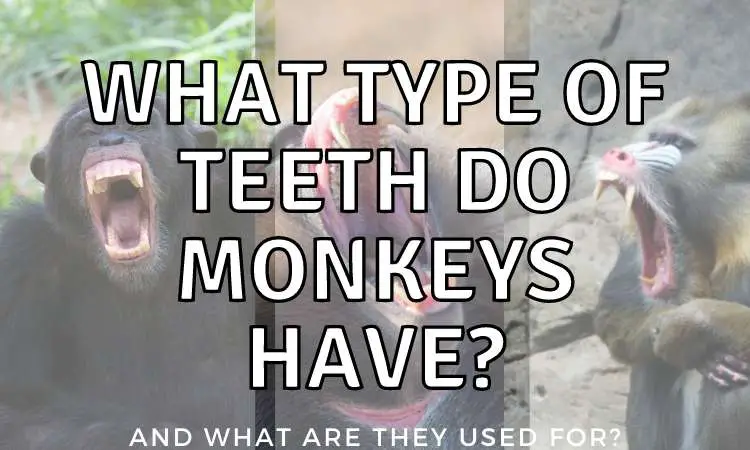While all primates including humans have teeth, the type of teeth that monkeys have is quite different from species to species and depends mostly on their diet.
They use their teeth for a variety of purposes – from stripping leaves off of branches to cracking open hard nuts.
All primates, including humans, have teeth that are very similar in structure and function: incisors, canines, premolars, and molars.
In many ways, the teeth of monkeys and apes are similar to our teeth, having strong molars to grind the vast plant material usually consumed by monkeys. However, the teeth of primates also have some unique features like their long, sharp, canines used primarily for display!
In contrast to humans, all monkeys have a pair of relatively long and sharp teeth flanking their four frontal (incisor) teeth. These cuspids or canine teeth are sharp, long, and curved inward. Mandrills and baboons are good examples of monkeys with long fang-like canines.
But as you might know, most monkeys and apes are not predators and would therefore not seem to need the long sharp fangs that for example tigers, lions, and wolves do.
While large monkeys like Mandrills are not considered to be dangerous, and their sharp teeth are not used for hunting, but they can, in theory, give a nasty bite if they are provoked. Other monkeys that have big sharp teeth include baboons, macaques, and drills.
So what is the function of sharp teeth in primates?
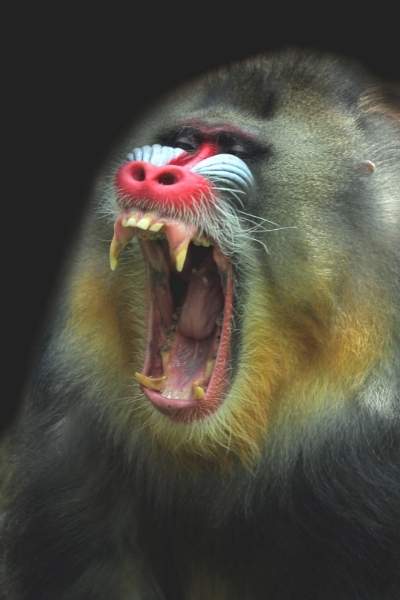
Most scientists believe that they are used as weapons in dominance fights and as tools to help in food acquisition.
Even though most monkeys may just eat fruit or plant material, the fibers of some plants can be hard to rip apart with flat molars alone.
The social dynamics of most monkey groups are strong and important drivers of evolution. It is possible that the need for sharp canine teeth has evolved to help in dominance fights, which led to their persistence over time.
Whatever the function, it is clear that monkey teeth are specially adapted for their unique way of life. And monkeys that have a strong social dominance hierarchy will tend to develop more “scary” features, such as strong colors and fangs.
As we learn more about the biology and behavior of monkeys, we are sure to gain a better understanding of these fascinating creatures and the important role they play in tropical ecosystems. But let’s start by taking a closer look at the teeth of monkeys and see what makes them so special!
Contents
What kind of Teeth Do Monkeys Have?
In general, monkeys have the same kind of teeth as humans, except for a set of sharp, long canines that curve inwards. This helps them to grip onto food as they bite into it. Their teeth are generally also strong, which allows them to crush hard nuts and fruits.
Another important aspect of monkey teeth is that their number differs between the major groups of monkeys.
How Many Teeth Do Monkeys Have?
Well, it depends on what types of monkeys we are talking about! They have either 32 or 36 teeth in total.
Old World Monkeys have 32 teeth in total – the same number as humans do! They generally have 16 in the upper jaw and 16 in the lower. However, the New World Monkeys, or platyrrhines, can have up to 36 teeth due to their extra set of premolars!
The front four teeth on both the top and bottom jaws are called incisors and are used for cutting. The next two are called canines and they’re sharp and pointy – perfect for catching prey. Then there are the premolars and molars, which are used for grinding food up.
If you have read my previous blog post on the different types of monkeys, you will know that there are two main groups: The Old World monkeys and the New World Monkeys. And one of the important differences is in their teeth!
Old World monkeys and New World monkeys have different types of teeth. Old World monkeys typically have sharper, longer canine teeth than New World monkeys. New World monkeys typically have more rounded molars.
However, most importantly, many New World monkeys have an extra set of molar teeth!
Some New World monkeys have three premolar teeth whereas Old World monkeys only have two premolars. This means that the New World Monkeys, like the Howler monkey or Bald Uakari, have 36 teeth!
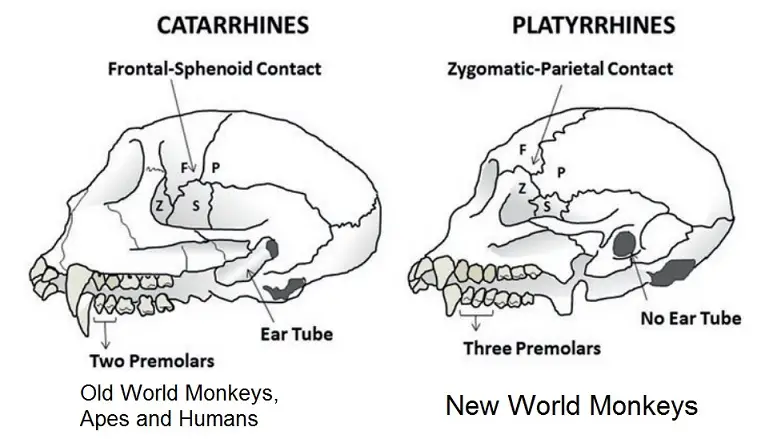
This is because Old World monkeys and New World monkeys evolved from different ancestors – the Old World monkeys from the Catarrhini group and the New World monkeys from the Platyrrhini group.
Do all monkeys have teeth?
Yes, all primates have teeth. This includes monkeys, apes, and humans. However, some monkeys, like mandrills and baboons, have bigger teeth than others.
Are monkeys born with teeth?
No, monkeys, like humans, are not born with teeth. They start to grow their first teeth at around six months old, and they continue to grow until the monkey reaches adulthood. Some monkeys, like the Mandrill, have to wait up to 5 years for all their teeth to be outgrown and mature!
Do baby monkeys have different teeth than adults?
Yes, baby monkeys have fewer and different teeth than adult monkeys. A bit like humans, their incisors are smaller and their canines are not as sharp. And just like humans, they lack a few molars that will grow out as their jaw grows in size.
What do monkeys use their teeth for?
Monkeys use their teeth for a variety of purposes. They use their sharp incisors to cut through food, their canines to catch prey, and their premolars and molars to grind food up.
They also use their teeth in dominance fights and as tools to help them acquire food hidden by tough bark or other hard plant matter. When monkeys like the mandrill or Gelada baboon yawn, they show their teeth to indicate their role in the social hierarchy within monkey groups.
Meet the Gelada Monkey!

The Gelada monkey is only found in the highlands of Ethiopia. They are related to baboons, and males are known for their loud vocalizations that can be heard from a great distance. Although they may look a bit frightening, they are usually not aggressive towards humans and they themselves are eaten by servals, leopards, and hyenas.
They are also called bleeding-heart monkeys because of a red patch of skin on their chest. When females are ready to reproduce their patch becomes darker red with bumps.
They live on the ground and are herbivores and graze mainly on grasses. They use their extra strong and small fingers to help them pull grass from the ground to eat.
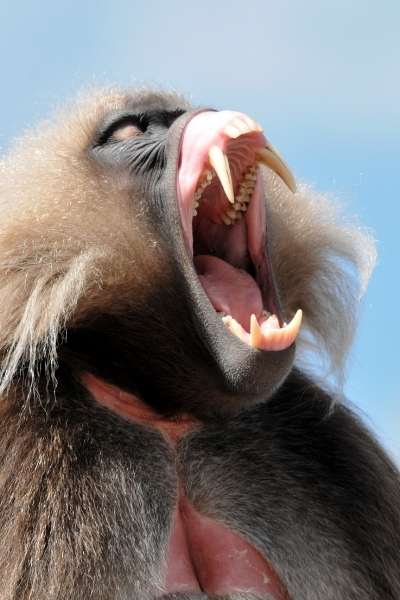
Gelada monkeys live in complex social groups of up to 10 individuals and they have a very interesting social structure. For example, the females are dominant over the males in groups which is unusual for most types of monkeys. Females also have very strong social bonds which are usually between females and their young offspring but can include other members as well.
Monkey Name: Gelada
Type of monkey (Family): Cercopithecidae
Type of monkey (Genus): Theropithecus
Species Name: Gelada
Adult Body Weight (lbs): 35.19
Adult Body Weight (Kg): 15.96
Size (Inches): 24.4
Maximum lifespan (years): 28
Newborn Weight (lbs): 1.02
Pregnancy Duration (months): 6
Typical Group Size: 10
Diet type: Picky
Monkeys per (Square Miles): 20
If you’re interested in the Gelada monkey, and how it uses its teeth, watch the video below:
Are monkey teeth stronger than human teeth?
Not necessarily, human teeth are not weaker than the average monkey teeth. We both have strong molars that are perfect for grinding up food, and many humans have the perks of better nutrition and dental care.
However, some of the bigger monkeys like mandrills and baboons have teeth almost the size of humans and much larger cuspids (fangs). But it is not only the fangs that vary in size and strength.
The Proboscis monkey, for example, needs particularly strong molars to chew because it actually chews its food twice – just like cows! It has a ruminant stomach that is dependent on very finely processed leaf material to be able to ferment and province nutrients for the bacteria that live in it.
So, while monkey teeth may not be stronger than human teeth on average, some species do have particularly strong dentition that helps them to survive in their environment.
Proboscis Monkey fact box!

The Proboscis monkey is only found in Borneo, and it’s named after its large, drooping nose. The male monkeys’ noses can get to be about the size of their entire face! The males with the largest noses are able to make louder honking noises, making them more attractive to the females.
They are usually made fun of and referred to as “Dutch monkeys” by the native people of Borneo as resembling the white, fat, red-nosed sailors that arrived from The Netherlands during the colonization of Borneo.
Unlike most other types of monkeys, this type is mostly herbivorous, and it mainly eats young leaves, shoots, and unripe fruits. Their bellies are very big so they can ferment the leaves. They live in the mangrove forests near the rivers and have webbed toes, possibly for swimming. They are one of the largest types of monkeys in Asia.
The babies have a blue face for the first few months after they are born. They live in groups with dominant males but are not very territorial towards other groups living in the same area, probably because there are plenty of leaves to eat.
- Monkey Name: Proboscis Monkey
- Type of monkey (Family): Cercopithecidae
- Type of monkey (Genus): Nasalis
- Species Name: larvatus
- Adult Body Weight (lbs): 27.04
- Adult Body Weight (Kg): 12.2
- Size (Inches): 25.491746049
- Maximum lifespan (years): 21
- Newborn Weight (lbs): 0.992079
- Pregnancy Duration (months): 5.50
- Typical Group Size: 11.25
- Diet type: Broad diet
- Monkeys per Square Mile: 3.47
Are monkeys’ teeth sharp?
Yes, the fangs of most monkeys are sharper and longer than human canine teeth, which makes them better suited for riping apart plant material and scaring enemies away.
The reason why mandrills have such big teeth is still unknown, but it is thought that they might be used for dominance fights or to help in food acquisition.
Are there monkeys that don’t have sharp teeth?
Well, yes, but they all have sharper fangs than humans do (as we don’t really have fangs…). As mentioned, some monkeys like the proboscis monkey have more blunt teeth that are not as sharp as other monkeys’ teeth.
Apes, on the other hand, have quite different teeth than those of most old-world monkeys. They have more flat molars that allow them to crush hard nuts and fruits. This is because apes are mainly herbivores, while monkeys are both herbivores and carnivores.
Are the teeth of monkeys and apes different?
Yes, the teeth of monkeys and apes are different. Monkeys have larger canines that curve inwards. While most non-human apes like the gorilla and chimpanzee still have somewhat enlarged canines compared to humans, they do not match those of most old-world monkeys like the Mandrill and Gelada monkeys.
Apes also have more flat molars, which allows them to crush hard nuts and fruits. This is because apes are mainly herbivores, while monkeys are both herbivores and carnivores.
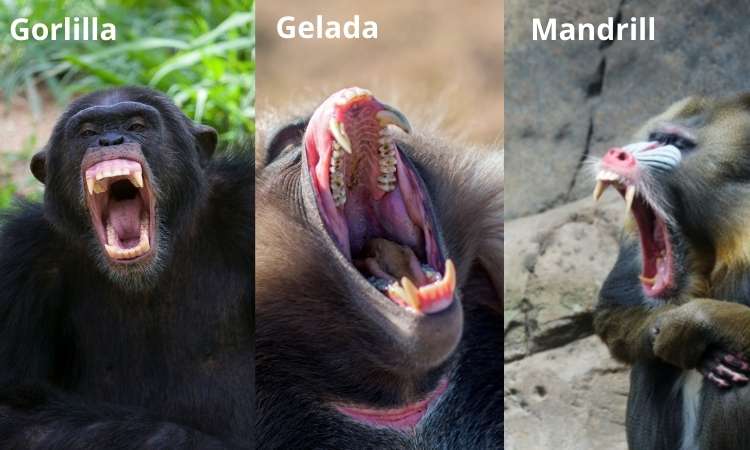
Which monkeys have the biggest teeth?
As you might have already guessed from the photos above, the mandrill has the biggest set of teeth and especially the fangs are particularly big even for monkeys, because they can get up to 3 inches (7 cm) long.
The Gelada baboon also has some pretty impressive teeth, with long canines that curve outwards just like the mandril.
Other monkeys that have big teeth include the Drill monkey, Baboons, Langurs, Macaques, and the black howler monkey.
But other monkeys like the proboscis monkey also have some pretty impressive molar teeth – its molars can be up to ¾ inch (almost two cm) long!
Why Do Mandrills Have Big Teeth?
It’s mostly a dominance thing – to impress females and scare away competitors. The bigger the teeth, the more impressive the mandrill looks, and the more likely it is to win a dominance battle.
Mandrill monkey facts!

The Mandrill is the world’s largest, heaviest, and most colorful monkey and is found in the forests of Africa. They have reddish-brown fur, and their face is covered in brightly-colored skin which can change color depending on their mood.
They are not related to baboons even though they look somewhat similar. Mandrills typically live in troops of 20 individuals but have been seen in groups that contain up to 1300 individuals, the largest group of primates ever recorded.
The color of the mandril’s face and rump is indicative of its placement in the group hierarchy, with brighter colors leading to a higher status. They are omnivores that eat a lot of different things, even including other vertebrates like small Antilope, but they are mostly non-predatory and prefer fruits.
They themselves are eaten by pythons, eagles, and leopards. They spend the most time on the ground and sometimes climb trees.
Many of you may know this type of monkey as the Mandrill named Rafiki in the “The Lion King” movies!
- Monkey Name: Mandrill
- Type of monkey (Family): Cercopithecidae
- Type of monkey (Genus): Mandrillus
- Species Name: sphinx
- Adult Body Weight (lbs): 36.7
- Adult Body Weight (Kg): 16.6
- Size (Inches): 29.87
- Maximum lifespan (years): 46
- Newborn Weight (lbs): 1.35
- Pregnancy Duration (months): 5.7
- Typical Group Size: 14
- Diet type: Broad diet
- Monkeys per Square Mile: 8.26
Are mandrills dangerous?
Mandrills are not typically considered dangerous, but they can certainly look imposing with their big teeth! They are usually quite docile and will only attack if they feel threatened.
Interestingly, male mandrills are not trying to threaten you with their impressive yawn, but rather to impose some kind of mutual respect – a respectful greeting if you like.
So, next time you see a mandrill yawning and showing off its impressive teeth, you’ll know what’s going on!
In fact, the biggest danger when interacting with mandrills is their excrement – it can contain parasites that can cause serious health problems! So always be sure to wash your hands thoroughly after coming in contact with a mandrill!
Do female and male monkeys have different teeth?
Within primates, male and female canine teeth are of different sizes. Female canines are usually smaller than male canines. Male canines are bigger because they can also be used to help males, secure mates.
In some species, like the mandrill, female and male teeth are very different in size. But for the most part, the remaining monkey teeth are pretty similar between the sexes.
The canines of male mandrills are typically more than 2 inches, while females usually only reach between 0.5 and 1 inches in length.

